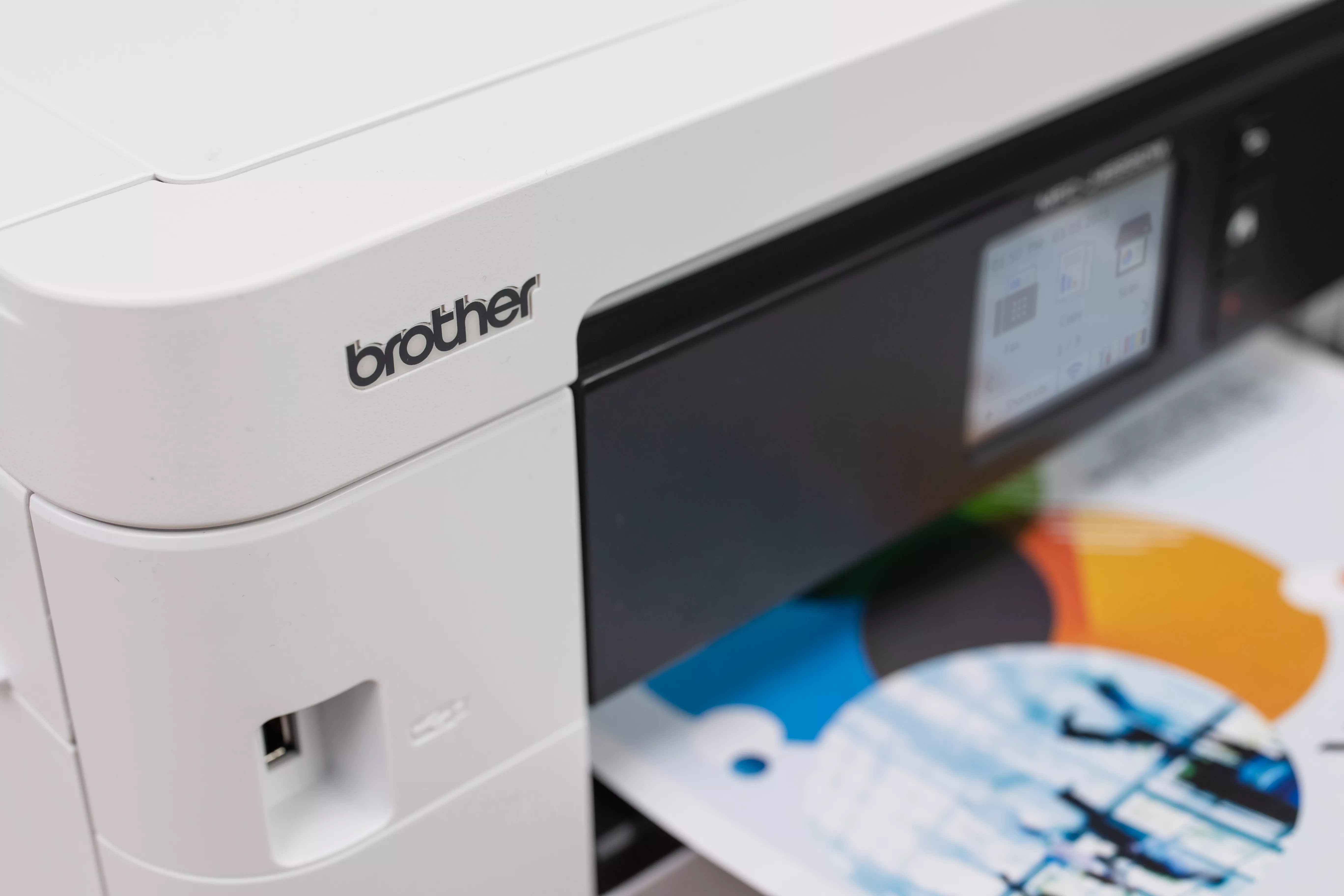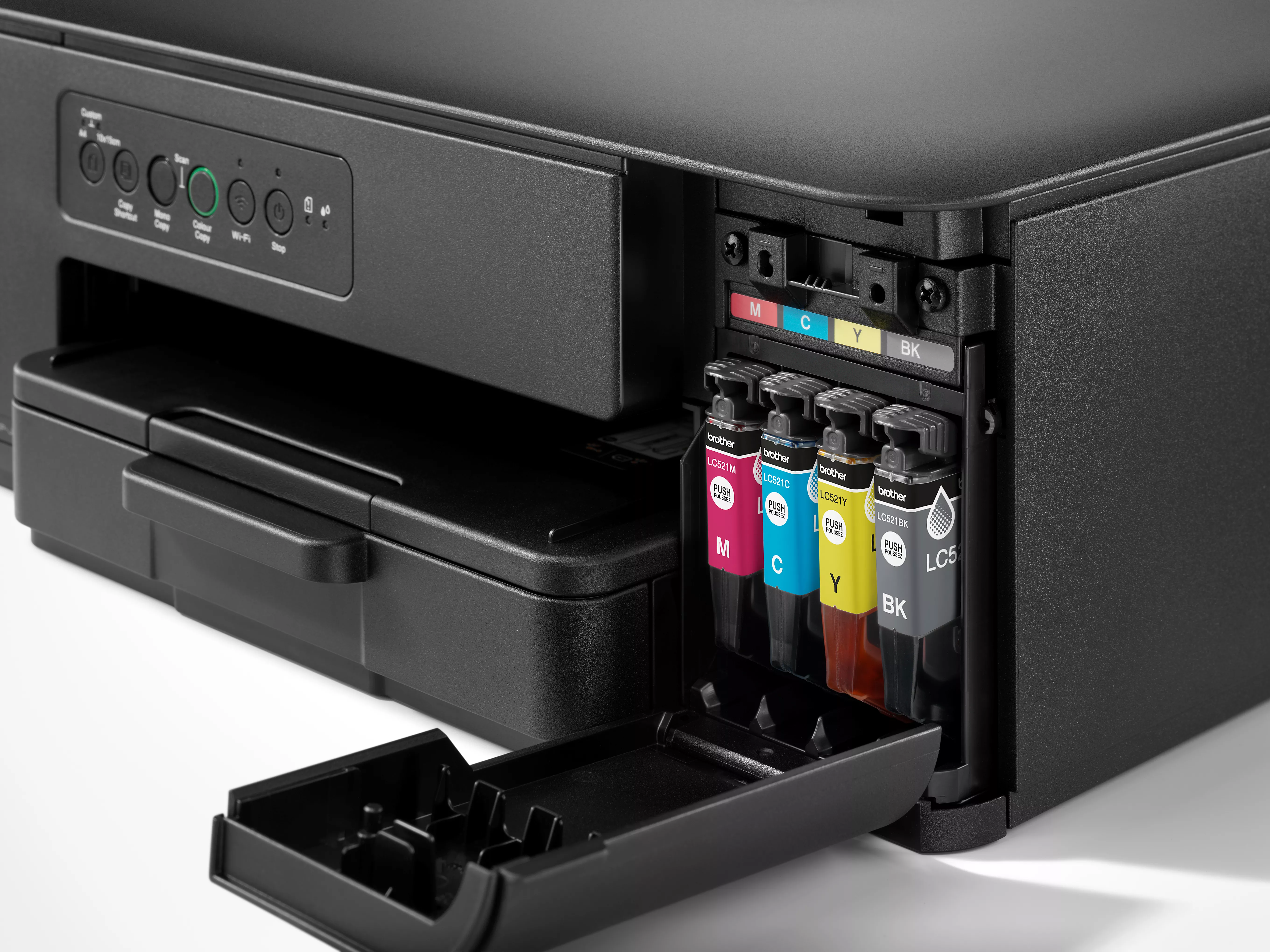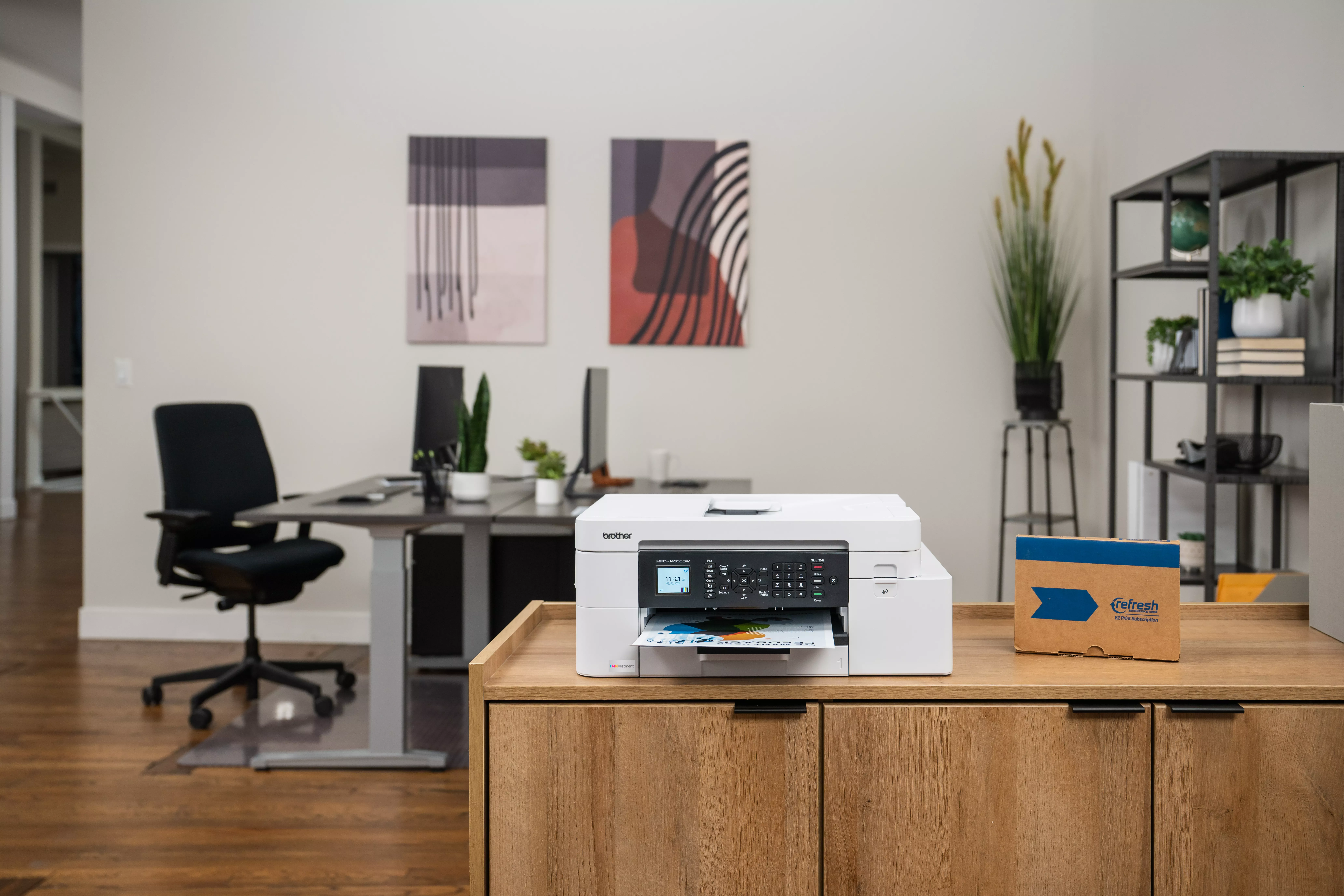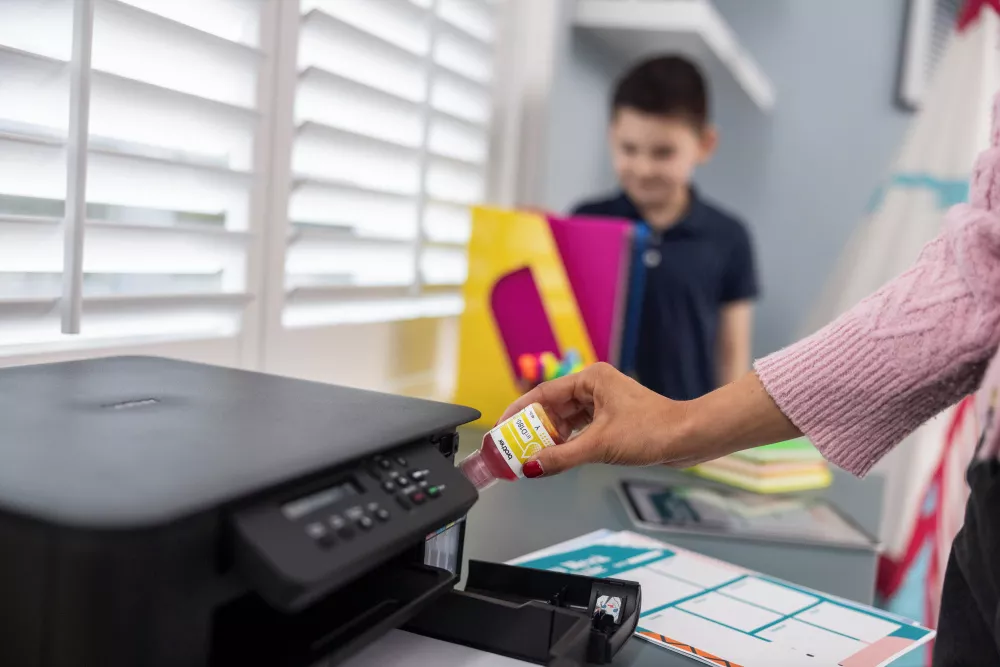Understanding Inkjet Printers and their Running Costs

Shopping for a new inkjet printer is seldom a straightforward task. At first glance, many models look nearly identical - sleek designs, similar features and promising print quality. But behind the packaging and casing, there's a big difference in how they work and what they cost to run. From the type of ink they use to how often you’ll need to replace supplies, the true cost and performance of printers go far beyond their initial price tags.
At Brother, we understand that choosing the right printer isn’t just about today’s print job - it’s about finding a reliable, cost-effective solution that works for the long haul. That’s why our inkjet range includes two distinct ranges - the INKvestment series and the refillable tankbenefit series - each built to suit different needs.

In this guide, we’ll walk you through everything you need to know to make an informed decision, including:
- How inkjet printers work and what sets them apart
- Why ink choice (pigment vs dye) affects your results
- How to understand running costs through cost per page (CPP) and total cost of ownership (TCO)
- A breakdown of the INKvestment vs tankbenefit models with real examples and use cases
- Practical tips for choosing the right Brother inkjet printer based on your needs
By the end, you’ll have a clear idea which Brother inkjet printer best fits your usage, budget and expectations.
How do inkjet printers work?
Inkjet printers create images and text by spraying tiny droplets of ink through precision nozzles onto the paper. The type of ink delivery system varies between models - some use separate cartridges or tanks for black, cyan, magenta and yellow, while others combine all colours into a single tri-colour cartridge. All Brother inkjet printers use individual colour cartridges, so you only need to replace the colour you’ve used - helping reduce ink wastage and offering better cost efficiency over time.
A key difference between inkjet printers lies in the type of ink they use: pigment vs dye-based ink. Pigment inks contain microscopic solid particles that sit on the surface of the paper, producing sharper text, richer colours and greater resistance to water, smudging and fading. This makes them ideal for printing business documents, reports or archival-quality images. Dye-based inks, on the other hand, are water-soluble and soak into the paper fibres. While they can offer brighter colours on glossy media, they are typically less durable and only suited to everyday printing tasks like schoolwork or personal use.

Select Brother inkjet models like the MFC-J4555DW INKvestment Multi-Function Printer use premium pigment inks to deliver crisp, fade-resistant output. Meanwhile, ink tank models like the DCP-T780DW Refillable Ink Tank Printer use dye-based inks for lower-cost printing.
Each ink type comes with its own benefits, so the best choice depends on your usage habits, budget and the level of print quality you need.
Why are colour inks used even in mono printing?
Even if you're printing only black & white text, many colour inkjet printers still use small amounts of colour ink. This can be for nozzle maintenance (to keep colour nozzles functioning in case you switch to colour later), to balance pressure or to achieve deeper black shades. With Brother inkjet printers, this can be mitigated by selecting “Mono” or “Black & White” in the printer driver settings, which helps limit colour ink usage during B&W jobs.
Additionally, if one or more colour cartridges run out, most Brother inkjet models can still continue printing in black and white - provided certain conditions are met (e.g. the printer remains powered on and less than approximately four weeks have passed since the colour ink was depleted). It’s a handy feature that gives you time to top up your ink without putting your printing on hold.
Why does one empty colour cartridge stop the whole printer?
As mentioned above, printers often have built-in safeguards to protect the nozzles and print head. If a colour ink runs completely dry, printing all colours or even just black may stop. That prevents ink starvation or damage to nozzles. The good news is, Brother inkjet printers are designed with this in mind. In many models, if a colour runs out, you may still be able to print in black and white - so long as the printer stays powered on and it hasn’t been too long since the ink ran out (typically less than four weeks).
And if you print frequently (especially colour mixed with mono), having high-yield cartridges or ink bottles becomes very useful to avoid interruptions.

How much does an inkjet printer cost to run?
While it’s tempting to compare inkjet printers based solely on their upfront price, this approach doesn’t give you the full picture and it’s not always a fair comparison. Different printer models offer different features, ink technologies and cartridge systems that significantly affect their long-term cost and value.
For example, some inkjet printers may have a higher initial cost but come with high-yield ink cartridges or refillable tanks that dramatically reduce the cost per page over time. Others might be cheaper to buy but use smaller cartridges that need frequent replacement, driving up your total spend in the long run.
To make an accurate comparison, it’s better to consider total cost of ownership (TCO), which includes:
- The printer itself
- Ink replacement costs
- Paper and consumables
- Servicing and repairs
- Maintenance and downtime
- Time spent replacing/refilling cartridges
- Cost of recycling the printer and consumables
While there are many factors that contribute to total cost of ownership (TCO), a simple way to calculate it is:
TCO = Printer Cost + (Total Pages × Cost Per Page)
This is where cost per page becomes particularly useful. It’s a practical way to evaluate ongoing costs across different models - regardless of upfront price - and helps you make smarter, long-term decisions.

What Cost Per Page Means and Why It’s Critical
As mentioned above, to compare printers fairly, cost per page (CPP) is the key metric. It’s calculated by dividing the cost of a cartridge or refill bottle by the number of pages it reliably produces. A lower CPP means better value over time.
Example:
- A cartridge costing $28 and printing 250 pages = 11.2 cents per page
- A higher-yield or refillable option costing $48 but printing 500 pages = 9.6 cents per page
Even though the first printer may be cheaper upfront, it becomes significantly more expensive over time. It’s similar to standing in the supermarket aisle - what looks cheaper at first glance might actually cost more per 100g. Or buying an affordable washing machine that uses more water and energy. Printers work the same way: the cheaper one upfront could cost you more in the long run.
Comparing Brother’s inkjet printers
What is Brother INKvestment?
The Brother INKvestment range is designed to strike a balance between quality and running cost. These printers come with high-yield cartridges, deliver strong quality and include a generous supply of ink in the box to reduce or delay needing to replace the cartridges.
Key Features
- Premium pigment-based inks for sharp text and fade resistance
- Includes larger amounts of ink-in-box so you can print hundreds of pages before needing to purchase cartridge replacements
Examples:
- DCP-J1260W - comes with up to a year’s worth of ink in the box; features up to 16 ppm (pages per minute), 150-sheet paper input and high-yield ink cartridges (e.g. up to 500 pages black / 500 colour) 3
- MFC-J4555DW - comes with up to a year's worth of ink in the box and super high-yield ink cartridges (e.g. up to 5,000 pages black / 2,500 colour) 3
- MFC-J6955DW – comes with up to a year’s worth of ink in the box and super high-yield ink cartridges (e.g. up to 6,000 pages black / 5,000 colour) 3
What is Brother tankbenefit?
The Brother tankbenefit series uses refillable bottles rather than replaceable cartridges. Designed for price-conscious users, these printers deliver ultra-low running costs and high page yields, making them ideal for those who value long-term savings.
Key Features:
- Refillable bottles & large built‑in tanks
- Very low cost per page
- Designed for households, small businesses or shared printing environments where low CPP is the main priority
Example:
The Brother DCP‑T580DW tankbenefit ink tank printer can print up to 7,500 black & white pages and 5,000 colour pages4 from the bottles included. A replacement ink set costs roughly $25.75 for the BTD180BK bottle and $14.35 for the BTD180CMY bottles1 - making its cost per page significantly lower than many cartridge printers.
tankbenefit vs INKvestment: Which One Is Right for You?
Here’s a comparison table summarising feature and cost trade‑offs:
| INKvestment Printers | tankbenefit Printers | |
| Upfront Cost | Low (depending on the model) – entry-level model starts at $1991 | Moderate – entry-level model starts at $4491 |
| Cost per Page | Low – For example, the MFC-J4555DW delivers a cost per page of $0.02 for black and $0.03 for colour when using LC536BK/C/M/Y XXL high-yield ink cartridges2 | Very Low – The DCP-T580DW offers ultra-low running costs, with a cost per page of just $0.003 for both black and colour using BTD180BK/C/M/Y refillable ink bottles2 |
| Ink in-box / Initial Yield | Generous (up to 1‑2 years ink included depending on the model) - For example, the MFC-J4555DW with in-box cartridges cartridges can deliver up to 1,900 black pages and 1,950 colour pages3 | High (large refillable bottles): The BTD180BK delivers up to 7,500 black pages, while the BTD180CMY provides up to 5,000 colour pages4 |
| Print Speed & Features | Advanced features, premium pigment inks and faster print speeds depending on the model. Higher-spec models include A3 printing, faxing, additional security features, multi-purpose trays and better connectivity options | Basic features and dye-based inks |
| Best For | Home offices, businesses and remote workers who print regularly and want a balance of quality, convenience and low ongoing costs. | Home offices, small businesses or shared environments where minimising running costs is the top priority |
1. Based on recommended retail pricing - prices may vary by retailer/reseller. Check with Brother authorised retailers and resellers for the most up-to-date pricing
2. Based on recommended retail pricing - prices may vary by retailer/reseller. Check with Brother authorised retailers and resellers for the most up-to-date pricing
3. Approx. page yields are calculated in accordance with ISO/IEC 24711
4. The first time you use a set of ink bottles the machine will use an amount of ink to fill the delivery tubes. This process will only happen once. The amount of ink remaining will be approximately 7,125 pages BK and 4,450 pages CMY in accordance with ISO/IEC 24711
Note: Actual costs may vary depending on how much colour vs black-and-white you print. However, the trend is clear: tankbenefit offers the lowest cost per page at a slightly higher upfront price, while INKvestment offers a solid balance of affordability and features for users who want higher-quality output at a lower upfront price.

Which inkjet printer is right for you?
Here are a few examples of Brother inkjet models to consider, depending on use-case:
- For light home use/occasional prints
Compact and easy to use, the DCP-J1260W is a great fit for smaller spaces and everyday tasks. It offers high-quality printing, scanning and copying all from one device. With up to a year of ink included in the box and wireless connectivity for printing from laptops or mobile devices, it’s a reliable, budget-friendly choice for households.
- For regular home and small office use
The MFC-J4355DW or MFC-J4555DW is designed for hybrid work environments, combining functionality with efficiency. It features automatic 2-sided (duplex) printing, vibrant output, mobile and cloud connectivity and up to a year’s worth of ink included in the box. With added security features and a compact footprint, it's ideal for remote workers and small teams.
- For heavy printing (small business/shared usage)
The Brother MFC-J5955DW, MFC-J6955DW and MFC-J6975DW are robust multi-function printers purpose-built for business users who demand performance, reliability and value. Each model comes with up to one year of ink in-box and a 2-year return-to-base warranty:
- For low-cost printing and simpler operation
Brother’s tankbenefit DCP-T580DW or DCP-T780DW are built for reliable, low-cost printing. With refillable ink tanks, ultra-low running costs and clear ink level indicators, they’re ideal for households, schools or offices that need cost-effective printing.

Final thoughts: choosing the right inkjet printer for your needs
Deciding on a printer isn’t just about the upfront price - it’s about how well it meets your long-term needs. INKvestment printers strike a smart balance between cost and performance, offering fast print speeds, a generous volume of ink included in the box and a low cost per page at a more affordable upfront price. On the other hand, tankbenefit printers primarily use dye-based inks but deliver the lowest cost per page at a higher upfront price.
When choosing a model, consider how much you print each month, how often you’ll need colour, and whether features like fast print speeds, high print quality or mobile/cloud connectivity are important to your workflow.
Need help choosing? You can compare models side by side on the inkjet printers category page to see how included ink and page yields align with your usage.
Feel free to contact us if you have any questions, our team is always happy to help.

Resource Library
Be the first to receive exclusive offers and the latest news on our products and services directly in your inbox




